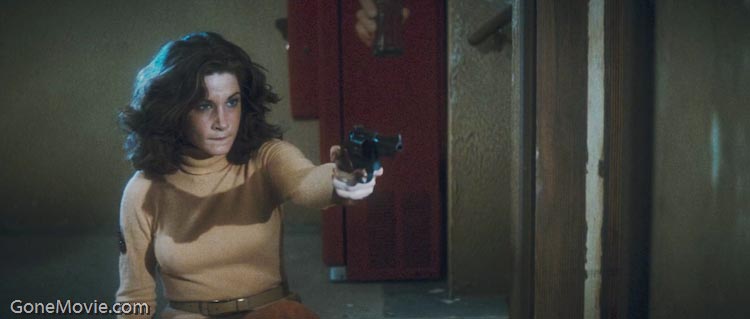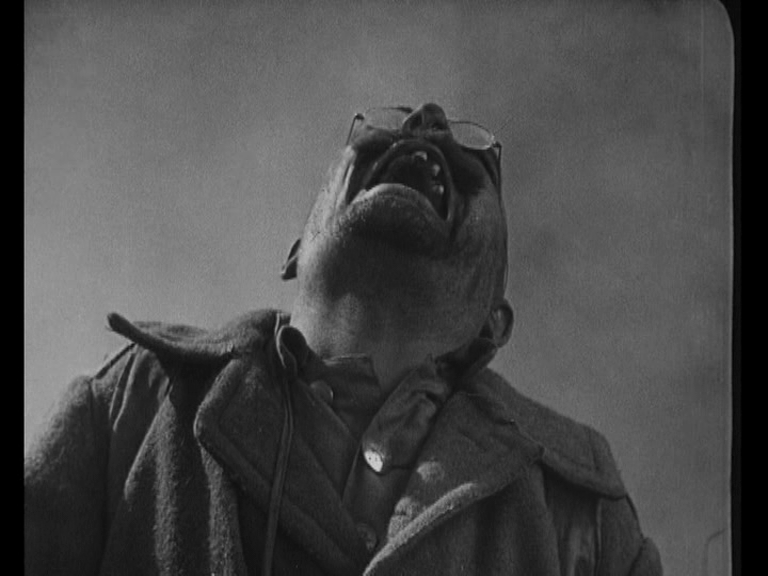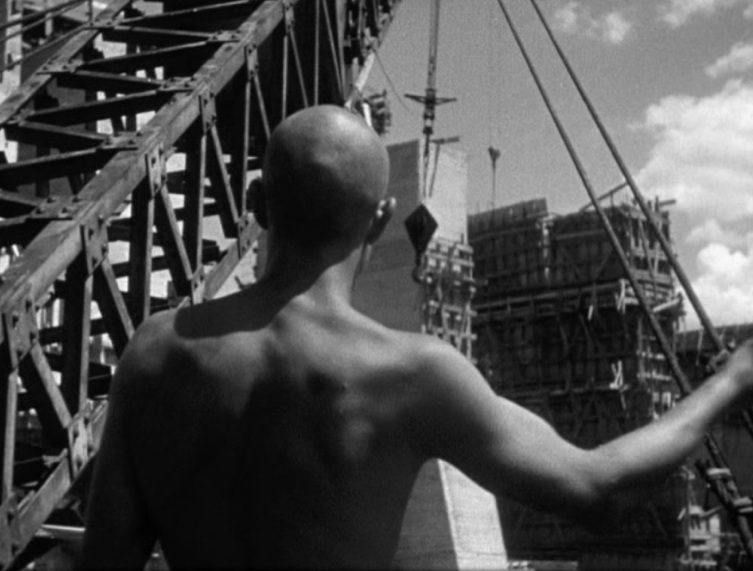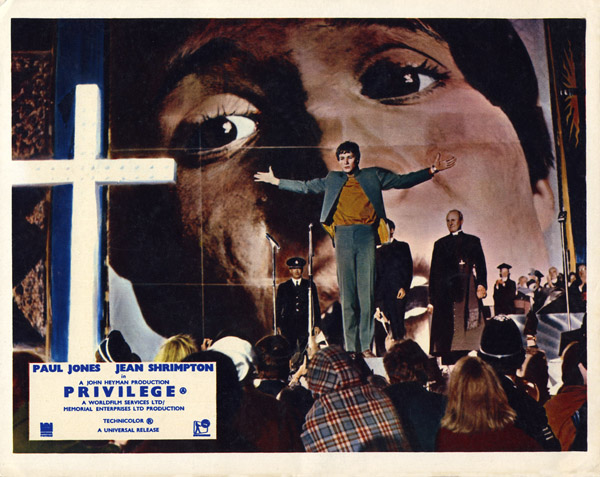From Take One (January 1979). — J.R.

In order to do justice to the mesmerizing effectiveness of Halloween, a couple of mini-backgrounds need to be sketched: that of writer-director John Carpenter, and that of the Mainstream Simulated Snuff Movie — a popular puritanical genre that I’ll call thw MSSM for short.
(1) On the basis of his first two low-budget features, it was already apparent that the aptly-named Carpenter was one of the sharpest Hollywood craftsmen to have come along in ages — a nimble jack-of-all-trades who composed his own music, doubled as producer (Dark Star) and editor (Assault on Precinct 13), and served up his genre materials with an unmistakably personal verve. Both films deserve the status of sleepers; yet oddly enough, most North American critics appear to have slept through them, or else stayed away. Somehow, the word never got out, apart from grapevine bulletins along a few film-freak circuits.

Dark Star proved that Carpenter could be quirky and funny; Assault showed that he could be quirky, funnu, and suspenseful all at once. Halloween drops the comedy, substitutes horror, and keeps you glued to your seat with ruthless efficiency from the first frame to the last. Read more
Written for my En movimiento column for the September 2013 issue of Caiman Cuadernos de Cine. Reseeing The Hanging Tree tonight, I was fascinated to discover how much McCabe and Mrs Miller was indebted to its prostitutes and its fires, and how often Daves could use a crane as if it were a musical instrument.— J.R.
“Many of Delmer Daves’s films are beloved, but to say that he remains a misunderstood and insufficiently appreciated figure in the history of American movies is a rank understatement.” This is how critic Kent Jones begins the second of his two essays accompanying the simultaneous Criterion releases on DVD and Blu-Ray of Jubal (1956) and 3:10 to Yuma (1957), the first two in a string of three Westerns that Daves made with Glenn Ford. (The third was Cowboy in 1958.)



I saw the two Blu-Rays, in reverse order, on the same day, and I agree entirely with Jones that 3:10 to Yuma (ignoring its reportedly lamentable recent remake) is a remarkable achievement — as much for Glenn Ford’s performance as a charismatic villain as it is for the diverse dramatic and visual nuances of Daves, working in black and white and widescreen. Speaking as someone for whom Glenn Ford’s heroism in my youth was as important as that of James Stewart or Cary Grant, I was also astonished by the unpredictable and multileveled killer-hipster and delicate gangleader-womanizer he creates here (and also grateful for a fascinating interview with his son and biographer Peter Ford, included as a bonus). Read more
Written for Cinema Guild’s Blu-Ray of Tsai Ming-liang’s Stray Dogs, released in mid-January 2015. — J.R.


Stray Dogs (2013), winner of the Grand Jury Prize at the 70th Venice International Film Festival, is Tsai Ming-liang’s tenth theatrical feature. It was described by Tsai at its premiere as his last, and in many ways it’s his most challenging. Considered as the apotheosis of his film work to date — which also includes eleven telefilms made between 1989 and 1985, and ten shorts or segments of portmanteau features, culminating in the 2014, 56-minute Journey to the West – it constitutes a kind of nervy dare to the viewer, and to prime oneself for it, it might help to look at Journey to the West first.


Even though both films flirt with stasis, usually in the midst of extremely long takes, they’re also performance pieces that hark back to Tsai’s roots in experimental theater and television. And the performers are not only hired actors but also unsuspecting street pedestrians, places, weather conditions, the camera, and, perhaps most crucial of all, viewers watching the activity of all of the above. If Tsai’s films typically qualify as questions rather than answers, foremost among the questions is how we perform as spectators – a question that we’re obliged to pose in relation to all the materials offered. Read more
The following was written for CITIZEN PETER, a very handsomely produced and multilingual 476-page book celebrating the late Peter von Bagh’s 70th birthday, in late August 2013, coedited by Antti Alanen and Olaf Möller. — J.R.

Preface
Peter von Bagh is the man who convinced me to purchase my first multiregional VCR in the early 1980s. So he has a lot to answer for — including, just for starters, my DVD column in Cinema Scope.


We’ve met at various times in Paris, London, New York, Southern California, Chicago, Helsinki, Sodankylä, and Bologna — and probably in other places as well, although these are the ones I currently remember. The first times were in Paris in the early 1970s, when he looked me up, and it must have been either in San Diego in 1977 or 1978 or in Santa Barbara between 1983 and 1987 that he convinced me to buy a multiregional VCR. Most likely it was the latter, where I was mainly bored out of my wits apart from my pastime of taping movies from cable TV, and Peter maintained that if we started swapping films through the mail, a multiregional VCR would allow me to play some of the treasures he could send me. Read more
I’m thrilled that my favorite academic film critic, James Naremore, finally brought out a collection of his critical and theoretical essays, and even more thrilled that its final section, “In Defense of Criticism,” includes an essay on me (along with essays on James Agee, Manny Farber, and Andrew Sarris, and extracts from Jim’s own ten-best columns for Film Quarterly between 2007 and 2010). Naremore’s essay about me ends with an email interview, and Jim has given me permission to reprint that text here. You can order his book, An Invention without a Future: Essays on Cinema — which also contains some wonderful material about Hawks, Hitchcock, Huston, Kubrick, Minnelli, and Welles, as well as about such topics as acting, auteurism, and literary adaptation — on Amazon. — J.R.

I took advantage of my friendship with Jonathan Rosenbaum to interview him on e-mail about the practical concerns or realpolitik of working as a film reviewer. His replies give us insight into at least one corner of the world of critical journalism:
JN: As a weekly film reviewer for the Chicago Reader, were you given the word length you needed for reviews? Was there any pressure, however subtle, to review big commercial films over art films and revivals? Read more
The following was written in February 2009 for a projected volume on Stanley Kubrick that was being prepared at the time by the Chicago-based magazine Stop Smiling, which commissioned this and a few shorter pieces by me for it, including a short “sidebar” text about James Naremore’s On Kubrick, written in April 2010, which I’ve appended to our exchange. [2023: An expanded second edition of this valuable book has recently appeared.] For a variety of reasons, including the discontinuation of the magazine, the book never appeared, and the editor, James Hughes, gave me permission to post it here, originally in September 2013….I obviously guessed wrong when I surmised here that Kubrick’s family would probably keep Fear and Desire “off the market”. — J.R.
Early Kubrick: An Exchange
By Jonathan Rosenbaum and James Naremore

Dear Jim,
As you note in your book on Kubrick, he removed his first feature, Fear and Desire (1953), from circulation at some point during the 60s. I know this couldn’t have been during the early 60s because I saw it for the first time in 1961 or ‘62, at the Charles Theater, a legendary, eclectic arthouse on the Lower East Side, when I was a freshman at NYU. Read more
Reprinted from my 2007 collection Discovering Orson Welles, but with illustrations added. (The first of these is a photo taken near Antibes, France, where the revamped Touch of Evil was scheduled to premiere, until Beatrice Welles threatened a lawsuit and halted the screening. Much later, she sent a letter of apology to Janet Leigh that I got to read at one point. Fortunately, this didn’t prevent me from enjoying a wonderful day with Janet Leigh, her daughter Kelly, and several others on the Côte d’Azur, capped by this photo of the Touch of Evil re-edit “crew” and then followed by a memorable dinner.)
The following —- an account of my work as consultant for Universal Pictures on the re-editing of Touch of Evil in 1997-98, based on a studio memo -— is the only thing I’ve ever written for Premiere. I knew one of the editors, Anne Thompson, from her previous stint as assistant editor at Film Comment, and when I proposed this piece to her, she checked with other editors at the magazine and reported back that there was a lot of enthusiastic interest. When I asked her what approach I should take, she urged me to write a first-person account of my experience of the project from beginning to end, which yielded a first version. Read more
Written for The Unquiet American: Transgressive Comedies from the U.S., a catalogue/collection put together to accompany a film series at the Austrian Filmmuseum and the Viennale in Autumn 2009. — J.R.

The brassy and obnoxious show-biz type that
Albert Brooks plays in his first and funniest feature
(1979) –- so close to Brooks’s own public persona that
he’s called Albert Brooks –- professes to be impervious
to all the self-consciousness that engulfs him.
Even when he’s shooting an extended documentary
about the life of a “typical” family in Phoenix,
Arizona in the style of the infamous 1973 cinéma-
vérité TV series An American Family, he claims
that anything the family does in front of the camera is
“right,” without ever admitting that the acute self-consciousness
created by his film and camera crew
ultimately has more to do with movies than with real
life. Charles Grodin brilliantly plays the animal
doctor at the head of this family, and Brooks is so
skillful at juggling all the mannerisms of pseudo-documentary
and all the specious claims of pop psychology
that his periodic and compulsive regressions to
old-time show business -– whether it’s the big-time
pop vocal in the opening sequence or the conflagration
inspired by Gone with the Wind at the
end –- manage to be both welcome and ludicrous. Read more
A slightly edited version of this article entitled “Devotional Reading” appeared in the November-December 2012 issue of Film Comment. For whatever it’s worth, I find Geoff Dyer’s taped interview about Stalker on Criterion’s Blu-Ray more perceptive than anything in this book. I guess he’s had more time to think about it by now. — J.R.


There are at least two intriguing recent trends reflected in the publications of Geoff Dyer’s Zona: A Book about a Film about a Journey to a Room (New York: Pantheon, 2012) and Adam Mars-Jones’s Noriko Smiling (London: Notting Hill Editions, 2011) — book-length studies of masterpieces (Stalker and Late Spring, respectively) and film criticism by amateurs (both of them prestigious literary Brits). A couple of much older attitudes underlying both is a view of cinema as literature by another means and, conversely, a view of film analysis as a literary and linear pursuit.
It’s obvious that what links these two trends historically is the phenomenon of home viewing, which has made every viewer a potential “expert” for the first time. Prior to VCRs and DVD and Blu-Ray players, the only tools available for studying films at length were 16 mm projectors and moviolas, most often belonging only to “professionals” of one kind or another. Read more
From the Chicago Reader (June 1, 2002). I’m delighted to be posting this around the same time that Godard spoke with reverence about this film in a lengthy taped interview just posted on Facebook. — J.R.


Earth (1930) is the most famous of Alexander Dovzhenko’s masterpieces, but this white-hot war film, made the previous year and screening only once in the Gene Siskel Film Center’s invaluable Dovzhenko retrospective, is in many ways his most dazzling silent picture. Though it was commissioned to glorify the 1918 struggle of Bolshevik workers at a Kiev munitions factory against White Russian troops, Dovzhenko’s view of wartime and battlefront morality is too ambiguous and multilayered to fit comfortably within any propaganda scheme. More clearly influenced by Sergei Eisenstein than any of Dovzhenko’s other pictures, it’s certainly the one that uses fast editing in the most exciting fashion, and some of the poetic uses of Ukrainian folklore that were Dovzhenko’s specialty have an almost drunken abandon here — as in the singing horses. (JR)

 Read more
Read more
From Monthly Film Bulletin, February 1978 (Vol. 45, No. 529). If memory serves, this was the last review I ever wrote for MFB, done on a trip back to London after I had moved to San Diego, although I believe I may have written a few features for the magazine after this, following its change of design and format somewhat later. (Postscript: This time, I’m afraid, my memory didn’t serve. I’ve just come across two more reviews I published in the MFB in 1984.) –- J.R.

White Buffalo, The
U.S.A., 1977Director: J. Lee Thompson
Cert–AA. dist–EMI. p.c–Dino De Laurentiis Corporation. p–Pancho Kohner. p. co-ordinator–Virginia Cook. p. manager–Hal Klein. location manager–R. Anthony Brown. asst. d–Jack Aldrvorth, Pat Kehoe. sc— Richard Sale. Based on his own novel. ph–Paul Lohmann. col–Technicolor; prints by Deluxe. process co-ordinator–Bill Hansard. ed—Michael F. Anderson. assoc. ed–Terence Anderson. p. designer–Tambi Larsen. set dec–James Berkey. sp. effects–Richard M. Parker. production sp. effects–Roy Downey. m/m.d–John Barry. cost–Eric Seelig. set cost— Dennis Fill. make-up–Phil Rhodes, Michael Hancock. titles–Dan Perri. sd. rec–Harlan Riggs. sd. re-rec–William McCaughey, Lyle J. Read more
Written for The Unquiet American: Transgressive Comedies from the
U.S., a catalogue/collection put together to accompany a film series at the
Austrian Filmmuseum and the Viennale in Autumn 2009. — J.R.

Long before the advent of Slavoj Zizek, U.S.
academic Joan Braderman in 1986 offered a bracing
exercise in standup theory and comic deconstruction
in this half-hour unpacking on video of the most successful
nighttime soap opera on television, which is
said to be the favorite series of one hundred million
people in 78 countries. Utilizing some of the special
effects of codirector and coeditor Manuel De Landa
to project herself literally into Dynasty and thereby
critique its cultural and ideological underpinnings,
Braderman manages to mix appreciation with scorn
in almost equal quantities.
 Read more
Read more
From the Chicago Reader (June 1, 2002). — J.R.

Alexander Dovzhenko’s first sound film, revolving around the construction of a giant dam on the Dnieper River, is one of his greatest, though it was poorly received in the Soviet Union when it came out in 1932. It’s only one of the eccentricities of this lyrical and monumental feature that the title refers to three different characters, and it’s telling that the father of one of them, an illiterate peasant who proudly spends his time fishing and loafing while everyone else works, is treated with considerable warmth. (A sequence in which he’s frightened when addressed by an outdoor loudspeaker evokes Chaplin as well as Tati.) As in all of Dovzhenko’s best work, the style veers closer to lyrical poetry (its opening sequence about the river) and portraiture (a later segment introducing us to various workers) than to narrative, though it’s innovative in other respects as well: the final sequence includes some striking jump cuts almost 30 years before Jean-Luc Godard purportedly invented them in Breathless. In Russian with subtitles. 90 min. (JR)

 Read more
Read more
From American Film (July-August, 1981). -– J.R.

This summer, Manhattan’s Whitney Museum of American Art is honoring animation — the work of many unsung individuals at the Walt Disney Studio between the late twenties and early forties — as high art.
Guest curator Greg Ford has selected approximately fifteen’ hundred individual pieces of art from the immense Disney archives, ranging from individual drawings to about a hundred films. And the Whitney has taken t0he unprecedented step of commissioning SITE — an innovative architectural and environmental arts organization — to mount these heretofore hidden treasures.
Perhaps best known for its eccentrically designed showrooms for the Best Products Company, with crumbled, notched, peeling, and tilted façades, SITE promotes the concept of architecture as art rather than as design. By its own description, SITE “rejects the traditional concerns of architecture as form and space in favor of architecture as information and thought.”
According to SITE project director Theodore Adamstein, “We’re using the vocabulary of cinema to present this work.” Thus the whole second-floor gallery space of the Whitney is painted black, and lit by a silvery light that highlights the exhibits while keeping spectators in relative darkness. Forty twelve-by-eight-foot screenlike frames, used in a variety of ways, contribute equally to the idea of museum space as movie house. Read more
From the Chicago Reader (May 17, 2002). — J.R.

La Commune (Paris, 1871)
*** (A must-see)
Directed by Peter Watkins
Written by Watkins with Agathe Bluysen and contributions from the cast members.
Some filmmakers say this is my work and I want it to stay that way. That is their right, and we respect that right. Those are the films we don’t buy, and those are the films we don’t transmit. — TV executive in The Universal Clock: The Resistance of Peter Watkins
I’ve been a fan and supporter of Peter Watkins for most of my life. A remarkable master technician and social visionary whose early work is filled to the brim with focused rage, he has created some of the most troubling, thought-provoking, even shattering films I know. This has helped make him persona non grata in mainstream TV and cinema and also in art houses, among academics, at festivals, and on cable TV. When his name does come up in those diverse realms, he’s often accused of being paranoid — though that hardly explains his pariah status.

Keeping up with his work is hard even for a sympathetic critic like me, and I can’t say I know it well. Read more






























